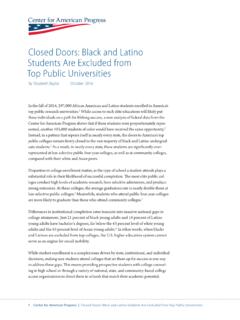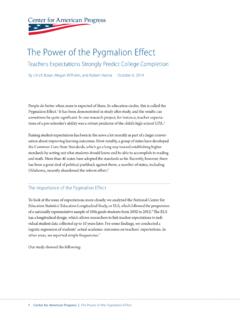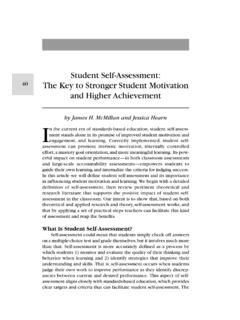Transcription of Effective Technical Assistance Principles
1 Photo/tinA FinebergEffective Technical Assistance PrinciplesLessons from Three Performance Pay ProgramsJessica L. Lewis and Matthew G. Springer December 2009 Effective Technical Assistance PrinciplesLessons from Three Performance Pay ProgramsJessica L. Lewis and Matthew G. Springer December 2009 1 Introduction and summary 4 Current performance pay policy landscape and its origins 8 Strategy for reviewing Technical Assistance initiatives 8 The initiatives 8 The methodology 13 Findings from Technical Assistance initiatives 13 Technical Assistance for the Teacher Advancement Program 17 Technical Assistance for Minnesota s Quality Compensation Program 21 Technical Assistance for Texas Program 23 Key features of Technical Assistance 28 Recommendations for Technical Assistance policy and practice 28 Align program and system goals 29 Address workplace barriers early on 29 Establish feedback mechanisms to know and predict participants needs 30 Provide meaningful training through applied learning 32 Conclusion 33 Endnotes 35 About the authors and acknowledgementsContentsintroduction and summary | 1
2 Introduction and summaryPay for performance in education is based on the premise that monetary incentives will provide schools with tools to recruit and retain highly Effective teachers and help educa-tors focus on the pedagogical and organizational changes required to improve student learning. Pay-for-performance programs may reward individual teachers, groups of teach-ers, or schools on the basis of any number of factors, including student test scores, class-room observations, teacher portfolios, or working in hard-to-staff schools or subject investment in domestic teacher pay-for-performance programs has been substantial. Many public school districts, and even entire states such as Florida, Minnesota, and Texas, are exploring performance pay as a means to improve administrator and teacher productiv-ity and recruit more qualified teachers.
3 Interest in such programs in the United States is growing, as is the number of programs under development and being implemented. However, mounting public interest in teacher compensation reform does not necessarily equate with universal support. While proponents now transcend political boundaries, a sturdy and influential base of individuals and organizations is still fundamentally opposed to modifying the single salary schedule for numerous reasons for example, they believe that performance pay would deteriorate the collaborative culture of teaching or that it is simply not possible to find a fair and objective means to evaluate educators contribution to student Nonetheless, avenues for more performance pay initiatives are blooming in the current political climate. Federal funding initiatives alone, such as the Teacher Incentive Fund and Race to the Top, offer millions in dollars to schools for the development of alternative educator compensation As of 2009, for example, TIF has allocated over $200 million to a handful of districts and states for the design and implementation of perfor-mance pay programs.
4 As pay-for-performance programs gain popularity in education, it is important that those implementing them not only buy into the policy but also gain the knowledge, skills, and capacity to implement them successfully. More than a handful of previous programs have floundered due to poor planning and design, insufficient training, and erratic funding. Technical Assistance , which involves train-ing in areas that aid schools or districts in program design and implementation, can play a vital role in tackling these issues, especially if the Assistance deals not only with necessary 2 Center for American Progress | Effective Technical Assistance Principlestopics for quality programs such as helping a school determine fair and quality measures of educator performance, developing data systems, and calculating bonus awards but also integrates tactics to ensure that lessons learned from training are sustained over time and embedded in the organization s culture and systems.
5 Moreover, these tactics ensure that key lessons for quality program operation are not only understood by school practitioners at the time of delivery, but persist throughout the duration of program implementation. This paper focuses on Technical Assistance provided to school systems interested in per-formance pay and how such Assistance can facilitate a higher quality of program design and implementation. The paper begins by first reviewing the current pay-for-performance landscape and the role of Technical Assistance in the midst of the current wave of compen-sation reform. It then examines the Technical Assistance associated with three prominent performance pay programs the national Teacher Advancement Program, or TAP, and two state-funded programs, Minnesota s Quality Compensation Plan, or Q Comp, and the District Awards for Teacher Excellence, or program in Texas before closing with a set of key recommendations for future practice.
6 More specifically, the report addresses the following three questions: What is the current state of performance pay policy and what is known about the poten-tial promises and pitfalls of such programs? What is the nature of Technical Assistance programs that are associated with several prominent performance pay programs? What are key Principles for successful Technical Assistance initiatives that sustain quality design and implementation of performance pay programs over time?After interviewing officials and reviewing documents associated with each of the three per-formance pay program s Technical Assistance initiatives, the paper identifies several notable features that are largely shared by the Technical Assistance providers associated with TAP, Q Comp, and programs. What is the substantive focus of Technical Assistance ? Technical Assistance providers do not limit training to current program participants but also reach out to prospective performance pay program participants.
7 In doing so they address issues such as securing funds grants, for example to participate in performance pay initiatives, understanding the nuts and bolts for implementing specific program guidelines, and raising overall aware-ness about performance pay reform. In many cases, performance pay is just one of several topics addressed, as Technical Assistance providers guide participants through a more holistic approach to teacher quality reform. At what points in time is Technical Assistance often provided? In all cases, Technical assis-tance providers work with schools and districts throughout the life of their program partici-pation. However, there is a general sense among Technical Assistance providers that Technical Assistance is and should be front loaded in the early stages of program implementation. introduction and summary | 3 What are common strategies for delivering Technical Assistance ?
8 Technical Assistance providers generally use a mixed-methods approach. Many use a combination of pre-scribed and customized training, some required and some nonmandatory. They value face-to-face, onsite Technical Assistance offerings but make use of real-time, readily accessible electronic resources, such as the Internet, as well. How is Technical Assistance evolving and why? First and foremost, Technical Assistance providers are certainly evolving their practices over time. They are primarily pushing to increase practitioner-to-practitioner sharing, advancing online learning opportunities, and targeting classroom teachers more directly, rather than relying so heavily on a train-the-trainer paper concludes with four Principles that should be used by Technical Assistance providers. These are Principles to facilitate a higher quality of design, implementation, and sustainability of performance pay programs over time.
9 Specifically, current and future providers need to: Systematically align the goals of performance pay programs with those of the particular education system. Address workplace barriers early on that might interfere with sustained application of training. Establish feedback mechanisms to know and predict program participants needs. Provide meaningful training through opportunities to apply Principles have broad application, but they are highly relevant to educator compensation reform and can facilitate long-lasting and ever-improving practice for performance pay programs. 4 Center for American Progress | Effective Technical Assistance PrinciplesCurrent performance pay policy landscape and its originsTeacher pay-for-performance programs date back to Great Britain in the early 1700s, with analogous ideas forming intermittently during the historical development of the K-12 public education system.
10 Efforts to institute teacher performance pay policies have emerged in virtually every decade since Denver and Des Moines adopted the single salary schedule in the early 20th century, which was seen as a way to level the playing field by remunerat-ing teachers on the same scale regardless of race, gender, or grade level taught. Teacher pay under the single salary schedule was determined according to two criteria thought to be the most important to teacher productivity: years of education and years of experience. Within two years of initial implementation of the single salary schedule, merit pay compen-sation began to wane. A 1923 National Education Association survey revealed 33 percent of sampled districts used merit pay, a figure that decreased to 18 percent in a subsequent 1928 survey. Not without note, in the 1940s, Thurgood Marshall then with the NAACP filed several lawsuits challenging unequal pay between white and black teachers.












